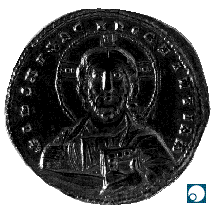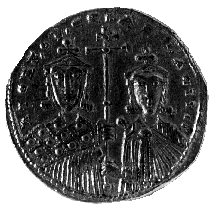



(146) Nicephorus II Phocas and Basil II - AV histamenon, A.D.
963-969, 4.35 g.
(inv. 91.289).
Obverse: Facing bust of Christ with cross-nimbus, r. raised
in blessing, l. holding book;
IhS(VS) XP(ISTO)S REX REGNANTIVM: Jesus Christ, King of those who rule.
Reverse: Facing busts of Nicephorus l., wearing loros
and crown with cross, and Basil II r., wearing chlamys and crown
with cross, both holding patriarchal cross between them; NICHFOP(VS) CE
BASIL AVGG (AVGVSTI abbreviated) B(ASILEIS) R(OMAION): Nicephorus and Basil,
Augusti, kings of the Romans.
Provenance: Abner Kreisberg, 1960.
Bibliography: P. Grierson, Byzantine Coins (London
1982).
At the premature death of Romanus II, his mother, Theophano, married the
famous general Nicephorus II Phocas in order to ward off threats to her
remaining two young sons. He is depicted here with the elder of the two,
Basil II, who would eventually become one of the greatest Byzantine emperors.
Nicephorus is shown to be the senior emperor by his position on the left,
his more elaborate dress, and his slightly larger scale. On the obverse
is a depiction of Christ Pantokrator done in a naturalistic style that contrasts
greatly with the stylized imperial portraits of the reverse.
During the reign of Nicephorus the gold coinage was divided into two types.
The first retained the weight and appearance of the solidus; it would now
be called the "histamenon" or "standard," of which this
coin is an example. The second was a debased coin called the "tetarteron"
or "quarter" owing to its lighter weight (see no. 147).
The debasement was probably necessary to finance Nicephorus' ambitious military
campaigns.
This coin also demonstrates a gradual change from Latin to Greek in the
inscriptions of Byzantine coins, with a sometimes confusing mixture of the
two languages on a single coin; here even the spelling of Nicephorus' name
uses both Latin and Greek letters.
E.N.J.



All contents copyright (c) 1996.
Lawrence University
All rights reserved.